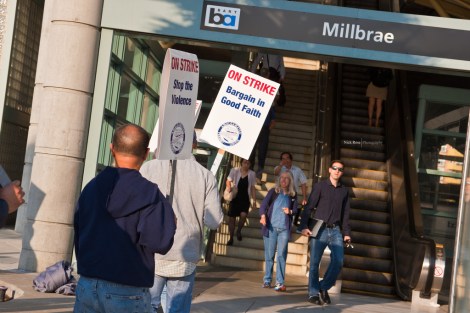Bay Area Rapid Transit workers are striking for the first time since 1997. Trains that connect the East Bay Area to San Francisco have ground to a halt, the highways are hella snarled, and don’t even get me started on what it’s like for bicyclists out there.
As far as public transportation goes, BART does not have a great reputation. It is not lovably surly like the New York subway, nor clean like the Washington, D.C., train system. It doesn’t even run past midnight on the weekends, but BART’s seats are full of bacteria, its escalators full of poop, its police full of controversy — and its workers full of frustration.
BART employees are negotiating for wage increases, along with more safety and security resources. If you saw this video of a naked acrobat assaulting train riders recently (NSFW!) that last bit may not come as much of a surprise. “Our members aren’t interested in disrupting the Bay Area, but management has put us in a position where we have no choice,” Antonette Bryant, president of Amalgamated Transit Union Local 1555, told the San Francisco Chronicle.
Local 1555 produced this video to make their case:
Both sides said they offered concessions, but they weren’t enough to reach an agreement. “Obviously, we’re disappointed. We feel we have a very good offer on the table,” a BART spokesman said.
But beyond the labor dispute, the BART strike highlights larger problems with the way San Francisco and its surrounding region has developed. BART was planned in the ’50s to ferry workers from their homes in the suburbs to their jobs in the city and back again. At first it only ran on weekdays, and was closed on weekends. It was, and continues to be, mainly oriented toward the suburbs, and really expensive.
Today the Bay Area is booming. Rents are skyrocketing, San Francisco apartment construction is at a 15-year high, and more techies are moving into the region’s central cities every day. With about 400,000 individual trips taken each day, BART ridership is at an all-time high. This past Sunday was the system’s busiest ever. During peak times, trains are filled to overflowing.
Now, with the transit workers striking, many of those would-be riders are clogging the streets in their cars, as some transportation alternatives are weak or nonexistent. The bridge that traverses the San Francisco Bay doesn’t have a pedestrian or bike path, and plans for the new bridge, currently under construction, only call for a bike path on half the bridge, making it useless to commuters.
Even BART has had a long-standing ban on bikes during rush hour. Monday was going to be the first day of an experimental end to that ban.
Yes, there are buses and ferries, both of which have also been shouldering the extra burden, but cars rule this place (and the AC Transit bus system has a brewing labor problem of its own). About 10 percent of the metro area is car-free. When two local reporters raced across the region Monday to see which was faster, car or alternative transport (walk, Amtrak train, ferry), the car driver won by nearly 40 minutes.
Tech companies have responded to limited local transit by running private bus lines to carry their workers from their urban homes to corporate campuses in the office park suburbs. These buses have become the symbol of a changing San Francisco.
But the region was ground zero for car and rideshare start-ups, even before they were start-ups. Bay Area Casual Carpool has been helping thousands of commuters for decades by filling empty seats in cars. And as the strike loomed, some commuters took to Reddit to organize other rideshares. (On the start-up side, rideshare company Avego bought BartStrike.com almost as soon as a strike looked likely, and began using it to promote the its service.)
But while rideshare start-ups might be convenient, and that private bus system might be functional, neither address the region’s failing infrastructure or its influx of new residents — they just make things easier for car-free folks who have cash. They are of little to no help to the 39 percent of BART’s riders who are low-income. Nor do they contribute to creating a functional transportation system for the many people who are increasingly interested in living a car-free life.
If the Bay Area wants to draw in more of those car-free folks, it doesn’t just need to fix BART — it needs to get its whole act together. That means deprioritizing cars and investing in bike and pedestrian infrastructure, creating a functional bus system (cheaper than trains!), building smarter and more densely — and improving labor conditions as well.
When we talk about resilient infrastructure, we don’t often talk about labor. But a train is only as good as the person operating it. And in BART’s case right now, that’s no one.




